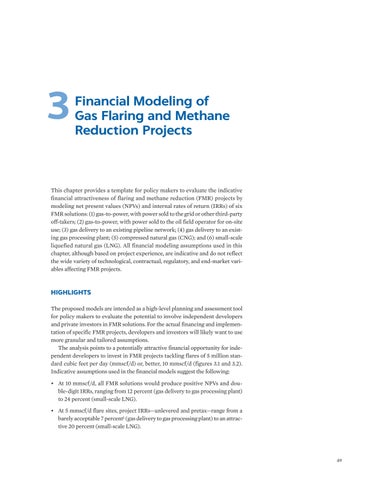3
Financial Modeling of Gas Flaring and Methane Reduction Projects
This chapter provides a template for policy makers to evaluate the indicative financial attractiveness of flaring and methane reduction (FMR) projects by modeling net present values (NPVs) and internal rates of return (IRRs) of six FMR solutions: (1) gas-to-power, with power sold to the grid or other third-party off-takers; (2) gas-to-power, with power sold to the oil field operator for on-site use; (3) gas delivery to an existing pipeline network; (4) gas delivery to an existing gas processing plant; (5) compressed natural gas (CNG); and (6) small-scale liquefied natural gas (LNG). All financial modeling assumptions used in this chapter, although based on project experience, are indicative and do not reflect the wide variety of technological, contractual, regulatory, and end-market variables affecting FMR projects.
HIGHLIGHTS The proposed models are intended as a high-level planning and assessment tool for policy makers to evaluate the potential to involve independent developers and private investors in FMR solutions. For the actual financing and implementation of specific FMR projects, developers and investors will likely want to use more granular and tailored assumptions. The analysis points to a potentially attractive financial opportunity for independent developers to invest in FMR projects tackling flares of 5 million standard cubic feet per day (mmscf/d) or, better, 10 mmscf/d (figures 3.1 and 3.2). Indicative assumptions used in the financial models suggest the following: • At 10 mmscf/d, all FMR solutions would produce positive NPVs and double-digit IRRs, ranging from 12 percent (gas delivery to gas processing plant) to 24 percent (small-scale LNG). • At 5 mmscf/d flare sites, project IRRs—unlevered and pretax—range from a barely acceptable 7 percent1 (gas delivery to gas processing plant) to an attractive 20 percent (small-scale LNG).
49


